Recent Progress of Plasmonic Perovskite Photodetectors
Abstract
1. Introduction
2. Introduction of Plasmonics
3. Figures of Merits for PDs
4. Plasmonic Nanoparticle-Based Pe-PDs
4.1. Perovskite–Plasmonic Nanoparticle
4.2. Perovskite–Graphene–Plasmonic Nanoparticle
4.3. Perovskite–Plasmonic Nanoparticle Assembly
4.4. Perovskite–Interlayer–Plasmonic Nanoparticle
4.5. Perovskite Photonic Crystal–Plasmonic Nanoparticle
4.6. Perovskite: Inorganic Heterojunction–Plasmonic Nanoparticle
5. Plasmonic Nanopattern-Based Pe-PDs
5.1. Perovskite–Plasmonic Nanopattern
5.2. Perovskite–AAO–Plasmonic Nanopattern
5.3. Perovskite–Plasmonic Multiple Pattern
5.4. Plasmonic Hot Carrier Inducing Structure
5.5. Plasmonic-Photonic Hybrid Structure
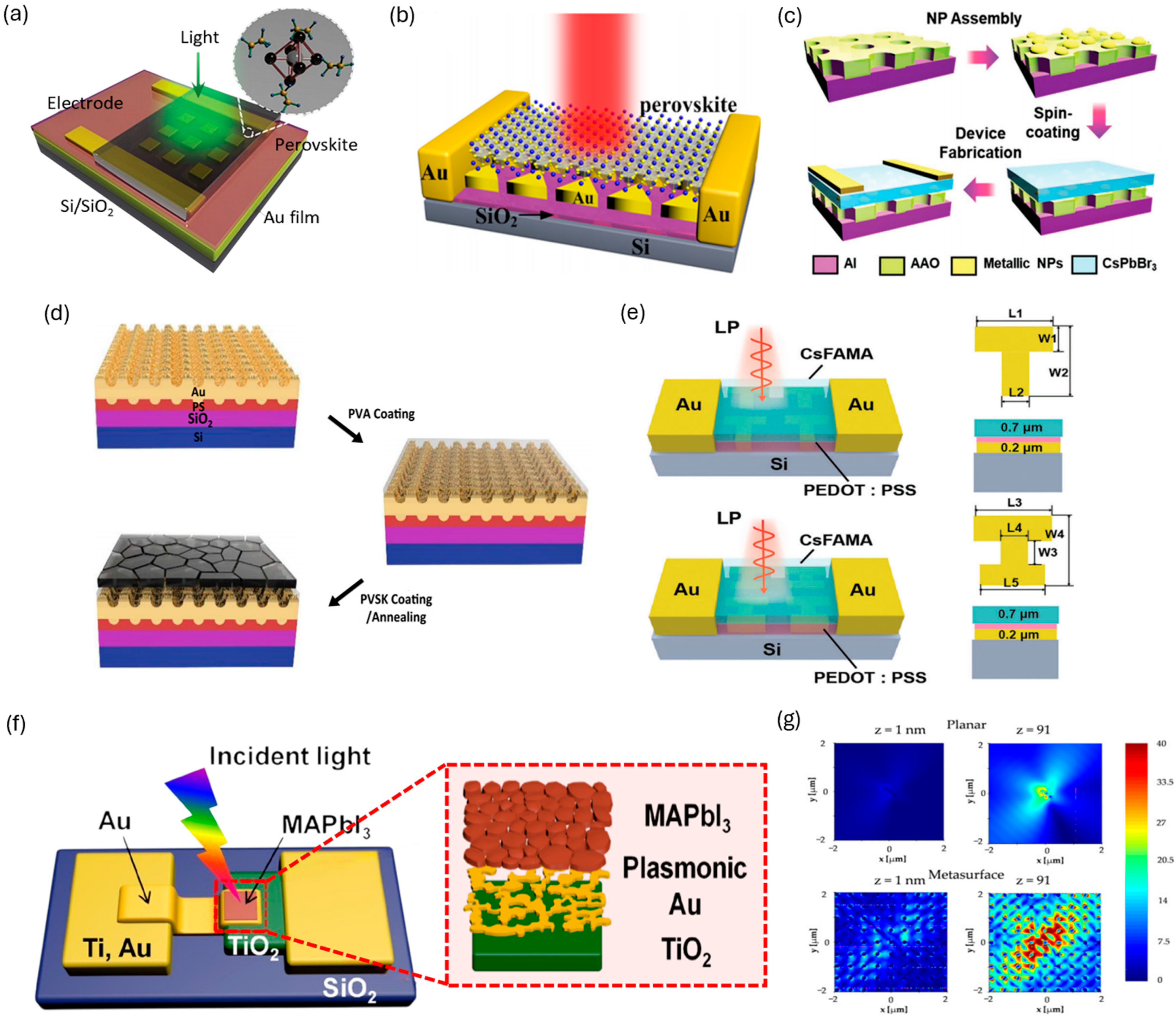
6. Chiral Plasmonics in Perovskites
6.1. Chiral Plasmonic Nanoparticles
6.2. Chiral Metasurfaces
6.3. Chiral Structures in Perovskites Optoelectronics
7. Conclusions
Author Contributions
Funding
Institutional Review Board Statement
Informed Consent Statement
Data Availability Statement
Conflicts of Interest
References
- Mitzi, D.B. Introduction: Perovskites. Chem. Rev. 2019, 119, 3033–3035. [Google Scholar] [CrossRef]
- Jena, A.K.; Kulkarni, A.; Miyasaka, T. Halide Perovskite Photovoltaics: Background, Status, and Future Prospects. Chem. Rev. 2019, 119, 3036–3103. [Google Scholar] [CrossRef]
- Manser, J.S.; Christians, J.A.; Kamat, P.V. Intriguing Optoelectronic Properties of Metal Halide Perovskites. Chem. Rev. 2016, 116, 12956–13008. [Google Scholar] [CrossRef]
- Zhao, Y.; Zhu, K. Organic–inorganic hybrid lead halide perovskites for optoelectronic and electronic applications. Chem. Soc. Rev. 2016, 45, 655–689. [Google Scholar] [CrossRef]
- Rogalski, A.; Wang, F.; Wang, J.; Martyniuk, P.; Hu, W. The Perovskite Optoelectronic Devices—A Look at the Future. Small Methods 2025, 9, 2400709. [Google Scholar] [CrossRef]
- Stranks, S.D.; Eperon, G.E.; Grancini, G.; Menelaou, C.; Alcocer, M.J.P.; Leijtens, T.; Herz, L.M.; Petrozza, A.; Snaith, H.J. Electron-Hole Diffusion Lengths Exceeding 1 Micrometer in an Organometal Trihalide Perovskite Absorber. Science 2013, 342, 341–344. [Google Scholar] [CrossRef]
- Chen, B.; Baek, S.-W.; Hou, Y.; Aydin, E.; De Bastiani, M.; Scheffel, B.; Proppe, A.; Huang, Z.; Wei, M.; Wang, Y.-K.; et al. Enhanced optical path and electron diffusion length enable high-efficiency perovskite tandems. Nat. Commun. 2020, 11, 1257. [Google Scholar] [CrossRef] [PubMed]
- Wang, P.; Wu, Y.; Cai, B.; Ma, Q.; Zheng, X.; Zhang, W.-H. Solution-Processable Perovskite Solar Cells toward Commercialization: Progress and Challenges. Adv. Funct. Mater. 2019, 29, 1807661. [Google Scholar] [CrossRef]
- Saki, Z.; Byranvand, M.M.; Taghavinia, N.; Kedia, M.; Saliba, M. Solution-processed perovskite thin-films: The journey from lab- to large-scale solar cells. Energy Environ. Sci. 2021, 14, 5690–5722. [Google Scholar] [CrossRef]
- Samiee, M.; Konduri, S.; Ganapathy, B.; Kottokkaran, R.; Abbas, H.A.; Kitahara, A.; Joshi, P.; Zhang, L.; Noack, M.; Dalal, V. Defect density and dielectric constant in perovskite solar cells. Appl. Phys. Lett. 2014, 105, 153502. [Google Scholar] [CrossRef]
- Kim, H.; Figueroa Morales, C.A.; Seong, S.; Hu, Z.; Muyanja, N.; Penukula, S.; Zheng, T.; Pizzo, Z.; Yim, C.S.; Lenert, A.; et al. Molecular design of defect passivators for thermally stable metal-halide perovskite films. Matter 2024, 7, 539–549. [Google Scholar] [CrossRef]
- Docampo, P.; Bein, T. A Long-Term View on Perovskite Optoelectronics. Acc. Chem. Res. 2016, 49, 339–346. [Google Scholar] [CrossRef] [PubMed]
- Zhao, R.; Gu, Z.; Li, P.; Zhang, Y.; Song, Y. Flexible and Wearable Optoelectronic Devices Based on Perovskites. Adv. Mater. Technol. 2022, 7, 2101124. [Google Scholar] [CrossRef]
- Kim, H.; Lee, J.W.; Han, G.R.; Kim, Y.J.; Kim, S.H.; Kim, S.K.; Kwak, S.K.; Oh, J.H. Highly Efficient Hole Transport Layer-Free Low Bandgap Mixed Pb–Sn Perovskite Solar Cells Enabled by a Binary Additive System. Adv. Funct. Mater. 2022, 32, 2110069. [Google Scholar] [CrossRef]
- Lee, Y.H.; Tang, Y.; Dani, R.; Lee, W.-J.; Kim, J.H.; Lee, G.; Sun, J.; Ma, K.; Jeong, S.H.; Xu, W.; et al. Self-Aligned Fluorinated-Organic Ligand for Boosting the Performance of Perovskite Solar Cells. ACS Appl. Mater. Interfaces 2025, 17, 26751–26758. [Google Scholar] [CrossRef] [PubMed]
- Yang, S.J.; Lee, Y.H.; Tateno, K.; Dou, L. Elemental segregation and dimensional separation in halide perovskite light-emitting diodes. Prog. Quantum Electron. 2024, 98, 100537. [Google Scholar] [CrossRef]
- Brenner, T.M.; Egger, D.A.; Kronik, L.; Hodes, G.; Cahen, D. Hybrid organic—Inorganic perovskites: Low-cost semiconductors with intriguing charge-transport properties. Nat. Rev. Mater. 2016, 1, 15007. [Google Scholar] [CrossRef]
- Velilla, E.; Ramirez, D.; Uribe, J.-I.; Montoya, J.F.; Jaramillo, F. Outdoor performance of perovskite solar technology: Silicon comparison and competitive advantages at different irradiances. Sol. Energy Mater. Sol. Cells 2019, 191, 15–20. [Google Scholar] [CrossRef]
- Saif, O.M.; Zekry, A.H.; Abouelatta, M.; Shaker, A. A Comprehensive Review of Tandem Solar Cells Integrated on Silicon Substrate: III/V vs Perovskite. Silicon 2023, 15, 6329–6347. [Google Scholar] [CrossRef]
- Cai, S.; Xu, X.; Yang, W.; Chen, J.; Fang, X. Materials and Designs for Wearable Photodetectors. Adv. Mater. 2019, 31, 1808138. [Google Scholar] [CrossRef]
- Chow, P.C.Y.; Someya, T. Organic Photodetectors for Next-Generation Wearable Electronics. Adv. Mater. 2020, 32, 1902045. [Google Scholar] [CrossRef]
- Hao, D.; Zou, J.; Huang, J. Recent developments in flexible photodetectors based on metal halide perovskite. InfoMat 2020, 2, 139–169. [Google Scholar] [CrossRef]
- Kim, H.; Seong, S.; Gong, X. Heterostructure Engineering of Solution-Processable Semiconductors for Wearable Optoelectronics. ACS Appl. Electron. Mater. 2023, 5, 5278–5290. [Google Scholar] [CrossRef]
- Lee, Y.H.; Song, I.; Kim, S.H.; Park, J.H.; Park, S.O.; Lee, J.H.; Won, Y.; Cho, K.; Kwak, S.K.; Oh, J.H. Perovskite Granular Wire Photodetectors with Ultrahigh Photodetectivity. Adv. Mater. 2020, 32, 2002357. [Google Scholar] [CrossRef]
- Lee, Y.H.; Lee, W.-J.; Lee, G.S.; Park, J.Y.; Yuan, B.; Won, Y.; Mun, J.; Yang, H.; Baek, S.-D.; Lee, H.; et al. Large-Scale 2D Perovskite Nanocrystals Photodetector Array via Ultrasonic Spray Synthesis. Adv. Mater. 2025, 37, 2417761. [Google Scholar] [CrossRef]
- Lee, Y.H.; Park, J.Y.; Niu, P.; Yang, H.; Sun, D.; Huang, L.; Mei, J.; Dou, L. One-Step Solution Patterning for Two-Dimensional Perovskite Nanoplate Arrays. ACS Nano 2023, 17, 13840–13850. [Google Scholar] [CrossRef]
- Demontis, V.; Durante, O.; Marongiu, D.; De Stefano, S.; Matta, S.; Simbula, A.; Ragazzo Capello, C.; Pennelli, G.; Quochi, F.; Saba, M.; et al. Photoconduction in 2D Single-Crystal Hybrid Perovskites. Adv. Opt. Mater. 2025, 13, 2402469. [Google Scholar] [CrossRef]
- Mastria, R.; Riisnaes, K.J.; Bacon, A.; Leontis, I.; Lam, H.T.; Alshehri, M.A.S.; Colridge, D.; Chan, T.H.E.; De Sanctis, A.; De Marco, L.; et al. Real Time and Highly Sensitive Sub-Wavelength 2D Hybrid Perovskite Photodetectors. Adv. Funct. Mater. 2024, 34, 2401903. [Google Scholar] [CrossRef]
- Wei, H.; Fang, Y.; Mulligan, P.; Chuirazzi, W.; Fang, H.-H.; Wang, C.; Ecker, B.R.; Gao, Y.; Loi, M.A.; Cao, L.; et al. Sensitive X-ray detectors made of methylammonium lead tribromide perovskite single crystals. Nat. Photonics 2016, 10, 333–339. [Google Scholar] [CrossRef]
- Min, J.; Demchyshyn, S.; Sempionatto, J.R.; Song, Y.; Hailegnaw, B.; Xu, C.; Yang, Y.; Solomon, S.; Putz, C.; Lehner, L.E.; et al. An autonomous wearable biosensor powered by a perovskite solar cell. Nat. Electron. 2023, 6, 630–641. [Google Scholar] [CrossRef]
- Morteza Najarian, A.; Vafaie, M.; Johnston, A.; Zhu, T.; Wei, M.; Saidaminov, M.I.; Hou, Y.; Hoogland, S.; García de Arquer, F.P.; Sargent, E.H. Sub-millimetre light detection and ranging using perovskites. Nat. Electron. 2022, 5, 511–518. [Google Scholar] [CrossRef]
- Zhang, H.-T.; Park, T.J.; Islam, A.N.M.N.; Tran, D.S.J.; Manna, S.; Wang, Q.; Mondal, S.; Yu, H.; Banik, S.; Cheng, S.; et al. Reconfigurable perovskite nickelate electronics for artificial intelligence. Science 2022, 375, 533–539. [Google Scholar] [CrossRef]
- Hou, H.-Y.; Tian, S.; Ge, H.-R.; Chen, J.-D.; Li, Y.-Q.; Tang, J.-X. Recent Progress of Polarization-Sensitive Perovskite Photodetectors. Adv. Funct. Mater. 2022, 32, 2209324. [Google Scholar] [CrossRef]
- Zheng, D.; Pauporté, T. Advances in Optical Imaging and Optical Communications Based on High-Quality Halide Perovskite Photodetectors. Adv. Funct. Mater. 2024, 34, 2311205. [Google Scholar] [CrossRef]
- Wang, G.; Qi, Y.; Zhou, Z.; Liu, Z.; Wang, R. Research Progress of Halide Perovskite Nanocrystals in Biomedical Applications: A Review. Inorganics 2025, 13, 55. [Google Scholar] [CrossRef]
- Tang, Y.; Jin, P.; Wang, Y.; Li, D.; Chen, Y.; Ran, P.; Fan, W.; Liang, K.; Ren, H.; Xu, X.; et al. Enabling low-drift flexible perovskite photodetectors by electrical modulation for wearable health monitoring and weak light imaging. Nat. Commun. 2023, 14, 4961. [Google Scholar] [CrossRef] [PubMed]
- Zheng, Y.; Zhan, Z.; Chen, Q.; Chen, J.; Luo, J.; Cai, J.; Zhou, Y.; Chen, K.; Xie, W. Highly Sensitive Perovskite Photoplethysmography Sensor for Blood Glucose Sensing Using Machine Learning Techniques. Adv. Sci. 2024, 11, 2405681. [Google Scholar] [CrossRef]
- Zhang, X.; Liu, X.; Sun, B.; Ye, H.; He, C.; Kong, L.; Shi, T.; Liao, G.; Liu, Z. Broadening the Spectral Response of Perovskite Photodetector to the Solar-Blind Ultraviolet Region through Phosphor Encapsulation. ACS Appl. Mater. Interfaces 2021, 13, 44509–44519. [Google Scholar] [CrossRef]
- Zhang, S.; Zhu, W.; Zhang, X.; Mei, L.; Liu, J.; Wang, F. Machine learning-driven fluorescent sensor array using aqueous CsPbBr3 perovskite quantum dots for rapid detection and sterilization of foodborne pathogens. J. Hazard. Mater. 2025, 483, 136655. [Google Scholar] [CrossRef] [PubMed]
- Zhao, D.; Choi, Y.-W.; Yokota, T.; Someya, T.; Park, N.-G. Halide Perovskite Radiation Detectors: Conventional Imaging Applications and New Opportunities. Adv. Funct. Mater. 2025, e13676. [Google Scholar] [CrossRef]
- Riisnaes, K.J.; Alshehri, M.; Leontis, I.; Mastria, R.; Lam, H.T.; De Marco, L.; Coriolano, A.; Craciun, M.F.; Russo, S. 2D Hybrid Perovskite Sensors for Environmental and Healthcare Monitoring. ACS Appl. Mater. Interfaces 2024, 16, 31399–31406. [Google Scholar] [CrossRef]
- Long, G.; Sabatini, R.; Saidaminov, M.I.; Lakhwani, G.; Rasmita, A.; Liu, X.; Sargent, E.H.; Gao, W. Chiral-perovskite optoelectronics. Nat. Rev. Mater. 2020, 5, 423–439. [Google Scholar] [CrossRef]
- Kim, H.; Choi, W.; Kim, Y.J.; Kim, J.; Ahn, J.; Song, I.; Kwak, M.; Kim, J.; Park, J.; Yoo, D.; et al. Giant chiral amplification of chiral 2D perovskites via dynamic crystal reconstruction. Sci. Adv. 2024, 10, eado5942. [Google Scholar] [CrossRef]
- Rogalski, A.; Hu, W.; Wang, F.; Wang, Y.; Martyniuk, P. Perovskite versus Standard Photodetectors. Materials 2024, 17, 4029. [Google Scholar] [CrossRef]
- Yang, J.; Wang, W.; Bao, C.; Huang, W.; Wang, J. Toward practical applications of perovskite photodetectors: Advantages and challenges. Matter 2025, 8, 102207. [Google Scholar] [CrossRef]
- Furlan, F.; Nodari, D.; Palladino, E.; Angela, E.; Mohan, L.; Briscoe, J.; Fuchter, M.J.; Macdonald, T.J.; Grancini, G.; McLachlan, M.A.; et al. Tuning Halide Composition Allows Low Dark Current Perovskite Photodetectors with High Specific Detectivity. Adv. Opt. Mater. 2022, 10, 2201816. [Google Scholar] [CrossRef]
- Hong, E.; Nodari, D.; Furlan, F.; Angela, E.; Panidi, J.; McLachlan, M.A.; Gasparini, N. Strain-Induced α-Phase Stabilization for Low Dark Current FAPI-Based Photodetectors. Adv. Opt. Mater. 2024, 12, 2302712. [Google Scholar] [CrossRef]
- Xing, R.; Li, Z.; Zhao, W.; Wang, D.; Xie, R.; Chen, Y.; Wu, L.; Fang, X. Waterproof and Flexible Perovskite Photodetector Enabled By P-type Organic Molecular Rubrene with High Moisture and Mechanical Stability. Adv. Mater. 2024, 36, 2310248. [Google Scholar] [CrossRef] [PubMed]
- Hong, E.; Tremlett, W.D.J.; Hart, L.; Hu, B.; Qiao, Z.; Sukpoonprom, P.; Fearn, S.; Angela, E.; Brunetta, M.; Koutsogeorgis, D.C.; et al. Ferrocene Derivatives Enable Ultrasensitive Perovskite Photodetectors with Enhanced Reverse Bias Stability. Adv. Funct. Mater. 2025, 2424556. [Google Scholar] [CrossRef]
- Nodari, D.; Hart, L.J.F.; Sandberg, O.J.; Furlan, F.; Angela, E.; Panidi, J.; Qiao, Z.; McLachlan, M.A.; Barnes, P.R.F.; Durrant, J.R.; et al. Dark Current in Broadband Perovskite–Organic Heterojunction Photodetectors Controlled by Interfacial Energy Band Offset. Adv. Mater. 2024, 36, 2401206. [Google Scholar] [CrossRef]
- Ai, B.; Fan, Z.; Wong, Z.J. Plasmonic–perovskite solar cells, light emitters, and sensors. Microsyst. Nanoeng. 2022, 8, 5. [Google Scholar] [CrossRef] [PubMed]
- Siavash Moakhar, R.; Gholipour, S.; Masudy-Panah, S.; Seza, A.; Mehdikhani, A.; Riahi-Noori, N.; Tafazoli, S.; Timasi, N.; Lim, Y.-F.; Saliba, M. Recent Advances in Plasmonic Perovskite Solar Cells. Adv. Sci. 2020, 7, 1902448. [Google Scholar] [CrossRef] [PubMed]
- Li, J.; Cushing, S.K.; Meng, F.; Senty, T.R.; Bristow, A.D.; Wu, N. Plasmon-induced resonance energy transfer for solar energy conversion. Nat. Photonics 2015, 9, 601–607. [Google Scholar] [CrossRef]
- Cho, S.; Yang, Y.; Soljačić, M.; Yun, S.H. Submicrometer perovskite plasmonic lasers at room temperature. Sci. Adv. 2021, 7, eabf3362. [Google Scholar] [CrossRef]
- Wang, Y.-Y.; Lee, X.-H.; Chen, C.-H.; Yuan, L.; Lai, Y.-T.; Peng, T.-Y.; Chen, J.-W.; Chueh, C.-C.; Lu, Y.-J. Plasmon-enhanced exciton relocalization in quasi-2D perovskites for low-threshold room-temperature plasmonic lasing. Sci. Adv. 2025, 11, eadu6824. [Google Scholar] [CrossRef]
- Carretero-Palacios, S.; Jiménez-Solano, A.; Míguez, H. Plasmonic Nanoparticles as Light-Harvesting Enhancers in Perovskite Solar Cells: A User’s Guide. ACS Energy Lett. 2016, 1, 323–331. [Google Scholar] [CrossRef] [PubMed]
- Wang, C.; Wang, X.; Luo, B.; Shi, X.; Shen, X. Plasmonics Meets Perovskite Photovoltaics: Innovations and Challenges in Boosting Efficiency. Molecules 2024, 29, 5091. [Google Scholar] [CrossRef]
- Demydov, P.; Lopatynskyi, A.; Hudzenko, I.; Chegel, V. The approaches for localized surface plasmon resonance wavelength position tuning. Short review. Semicond. Phys. Quantum Electron. Optoelectron. 2021, 24, 304–311. [Google Scholar] [CrossRef]
- Kunwar, S.; Pandit, S.; Jeong, J.-H.; Lee, J. Improved Photoresponse of UV Photodetectors by the Incorporation of Plasmonic Nanoparticles on GaN Through the Resonant Coupling of Localized Surface Plasmon Resonance. Nano-Micro Lett. 2020, 12, 91. [Google Scholar] [CrossRef]
- Wen, X.; Deng, S. Plasmonic Nanostructure Lattices for High-Performance Sensing. Adv. Opt. Mater. 2023, 11, 2300401. [Google Scholar] [CrossRef]
- Li, M.; Cushing, S.K.; Wu, N. Plasmon-enhanced optical sensors: A review. Analyst 2015, 140, 386–406. [Google Scholar] [CrossRef]
- Zhang, J.; Zhang, L.; Xu, W. Surface plasmon polaritons: Physics and applications. J. Phys. D Appl. Phys. 2012, 45, 113001. [Google Scholar] [CrossRef]
- Lee, Y.H.; Lee, S.H.; Won, Y.; Kim, H.; Yang, S.J.; Ahn, J.; Mun, J.; Lee, J.H.; Dou, L.; Rho, J.; et al. Boosting the Performance of Flexible Perovskite Photodetectors Using Hierarchical Plasmonic Nanostructures. Small Struct. 2024, 5, 2300546. [Google Scholar] [CrossRef]
- Lee, Y.H.; Lee, T.K.; Song, I.; Yu, H.; Lee, J.; Ko, H.; Kwak, S.K.; Oh, J.H. Boosting the Performance of Organic Optoelectronic Devices Using Multiple-Patterned Plasmonic Nanostructures. Adv. Mater. 2016, 28, 4976–4982. [Google Scholar] [CrossRef]
- Ha, M.; Kim, J.-H.; You, M.; Li, Q.; Fan, C.; Nam, J.-M. Multicomponent Plasmonic Nanoparticles: From Heterostructured Nanoparticles to Colloidal Composite Nanostructures. Chem. Rev. 2019, 119, 12208–12278. [Google Scholar] [CrossRef]
- Park, Y.; Choi, J.; Lee, C.; Cho, A.-N.; Cho, D.W.; Park, N.-G.; Ihee, H.; Park, J.Y. Elongated Lifetime and Enhanced Flux of Hot Electrons on a Perovskite Plasmonic Nanodiode. Nano Lett. 2019, 19, 5489–5495. [Google Scholar] [CrossRef]
- Huang, X.; Li, H.; Zhang, C.; Tan, S.; Chen, Z.; Chen, L.; Lu, Z.; Wang, X.; Xiao, M. Efficient plasmon-hot electron conversion in Ag–CsPbBr3 hybrid nanocrystals. Nat. Commun. 2019, 10, 1163. [Google Scholar] [CrossRef]
- Bueno, J.; Carretero Palacios, S.; Anaya, M. Synergetic Near- and Far-Field Plasmonic Effects for Optimal All-Perovskite Tandem Solar Cells with Maximized Infrared Absorption. J. Phys. Chem. Lett. 2024, 15, 2632–2638. [Google Scholar] [CrossRef] [PubMed]
- Xu, T.; Li, W.; Wu, X.; Ahmadi, M.; Xu, L.; Chen, P. High-performance blue perovskite light-emitting diodes based on the “far-field plasmonic effect” of gold nanoparticles. J. Mater. Chem. C 2020, 8, 6615–6622. [Google Scholar] [CrossRef]
- Dong, Y.; Xu, L.; Zhao, Y.; Wang, S.; Song, J.; Zou, Y.; Zeng, H. The Synergy of Plasmonic Enhancement and Hot-Electron Effect on CsPbBr3 Nanosheets Photodetector. Adv. Mater. Interfaces 2021, 8, 2002053. [Google Scholar] [CrossRef]
- Ali, A.; Kang, J.H.; Seo, J.H.; Walker, B. Effect of Plasmonic Ag Nanoparticles on the Performance of Inverted Perovskite Solar Cells. Adv. Eng. Mater. 2020, 22, 1900976. [Google Scholar] [CrossRef]
- Erwin, W.R.; Zarick, H.F.; Talbert, E.M.; Bardhan, R. Light trapping in mesoporous solar cells with plasmonic nanostructures. Energy Environ. Sci. 2016, 9, 1577–1601. [Google Scholar] [CrossRef]
- van Vliet, K.M. Noise Limitations in Solid State Photodetectors. Appl. Opt. 1967, 6, 1145–1169. [Google Scholar] [CrossRef] [PubMed]
- Dong, Y.; Gu, Y.; Zou, Y.; Song, J.; Xu, L.; Li, J.; Xue, J.; Li, X.; Zeng, H. Improving All-Inorganic Perovskite Photodetectors by Preferred Orientation and Plasmonic Effect. Small 2016, 12, 5622–5632. [Google Scholar] [CrossRef] [PubMed]
- Xi, Y.; Wang, X.; Ji, T.; Li, G.; Shi, L.; Liu, Y.; Wang, W.; Ma, J.; Liu, S.; Hao, Y.; et al. Plasmonic Resonance Enabling 2D Perovskite Single Crystal to Detect Telecommunication Light. Adv. Opt. Mater. 2023, 11, 2202423. [Google Scholar] [CrossRef]
- Sun, Z.; Aigouy, L.; Chen, Z. Plasmonic-enhanced perovskite–graphene hybrid photodetectors. Nanoscale 2016, 8, 7377–7383. [Google Scholar] [CrossRef] [PubMed]
- Lee, Y.H.; Park, S.; Won, Y.; Mun, J.; Ha, J.H.; Lee, J.H.; Lee, S.H.; Park, J.; Yeom, J.; Rho, J.; et al. Flexible high-performance graphene hybrid photodetectors functionalized with gold nanostars and perovskites. NPG Asia Mater. 2020, 12, 79. [Google Scholar] [CrossRef]
- Yadav, S.N.S.; Hanmandlu, C.; Patel, D.K.; Singh, R.K.; Chen, C.-Y.; Wang, Y.-Y.; Chu, C.-W.; Liang, C.-T.; Lin, C.-T.; Lu, Y.-J.; et al. Enhanced Photoresponsivity of Perovskite QDs/Graphene Hybrid Gate-Free Photodetector by Morphologically Controlled Plasmonic Au Nanocrystals. Adv. Opt. Mater. 2023, 11, 2300131. [Google Scholar] [CrossRef]
- La, J.A.; Kang, J.; Byun, J.Y.; Kim, I.S.; Kang, G.; Ko, H. Highly sensitive and fast perovskite photodetector functionalized by plasmonic Au nanoparticles-alkanethiol assembly. Appl. Surf. Sci. 2021, 538, 148007. [Google Scholar] [CrossRef]
- Kwon, H.; Lim, J.W.; Kim, D.H. Plasmonic perovskite photodetector with high photocurrent and low dark current mediated by Au NR/PEIE hybrid layer. J. Mater. Sci. Technol. 2025, 218, 45–53. [Google Scholar] [CrossRef]
- Ye, X.; Ma, C.; Lou, H.; Dai, J. Effect of SU-8 Encapsulated AgNPs on the Performance Enhancement of CH3NH3PbI3 Perovskite Photodetector. IEEE Photonics Technol. Lett. 2024, 36, 425–428. [Google Scholar] [CrossRef]
- Li, D.; Zhou, D.; Xu, W.; Chen, X.; Pan, G.; Zhou, X.; Ding, N.; Song, H. Plasmonic Photonic Crystals Induced Two-Order Fluorescence Enhancement of Blue Perovskite Nanocrystals and Its Application for High-Performance Flexible Ultraviolet Photodetectors. Adv. Funct. Mater. 2018, 28, 1804429. [Google Scholar] [CrossRef]
- Lin, C.; Wan, P.; Yang, B.; Shi, D.; Kan, C.; Jiang, M. Plasmon-enhanced photoresponse and stability of a CsPbBr3 microwire/GaN heterojunction photodetector with surface-modified Ag nanoparticles. J. Mater. Chem. C 2023, 11, 12968–12980. [Google Scholar] [CrossRef]
- Du, B.; Yang, W.; Jiang, Q.; Shan, H.; Luo, D.; Li, B.; Tang, W.; Lin, F.; Shen, B.; Gong, Q.; et al. Plasmonic-Functionalized Broadband Perovskite Photodetector. Adv. Opt. Mater. 2018, 6, 1701271. [Google Scholar] [CrossRef]
- Gu, Q.; Hu, C.; Yang, J.; Lv, J.; Ying, Y.; Jiang, X.; Si, G. Plasmon enhanced perovskite-metallic photodetectors. Mater. Des. 2021, 198, 109374. [Google Scholar] [CrossRef]
- Li, M.-Y.; Shen, K.; Xu, H.; Ren, A.; Lee, J.; Kunwar, S.; Liu, S.; Wu, J. Enhanced Spatial Light Confinement of All Inorganic Perovskite Photodetectors Based on Hybrid Plasmonic Nanostructures. Small 2020, 16, 2004234. [Google Scholar] [CrossRef]
- Li, Y.; Jia, Y.; Yang, H.; Wu, Y.; Cao, Y.; Zhang, X.; Lou, C.; Liu, X.; Huang, L.-B.; Yao, J. A Room-Temperature Terahertz Photodetector Imaging with High Stability and Polarization-Sensitive Based on Perovskite/Metasurface. Adv. Sci. 2025, 12, 2407634. [Google Scholar] [CrossRef] [PubMed]
- Righetto, M.; Lim, S.S.; Giovanni, D.; Lim, J.W.M.; Zhang, Q.; Ramesh, S.; Tay, Y.K.E.; Sum, T.C. Hot carriers perspective on the nature of traps in perovskites. Nat. Commun. 2020, 11, 2712. [Google Scholar] [CrossRef]
- Hopper, T.R.; Gorodetsky, A.; Frost, J.M.; Müller, C.; Lovrincic, R.; Bakulin, A.A. Ultrafast Intraband Spectroscopy of Hot-Carrier Cooling in Lead-Halide Perovskites. ACS Energy Lett. 2018, 3, 2199–2205. [Google Scholar] [CrossRef]
- Fu, J.; Xu, Q.; Han, G.; Wu, B.; Huan, C.H.A.; Leek, M.L.; Sum, T.C. Hot carrier cooling mechanisms in halide perovskites. Nat. Commun. 2017, 8, 1300. [Google Scholar] [CrossRef]
- Kim, H.; Han, G.R.; Kim, S.K.; Lyu, T.; Choi, W.; Lee, J.W.; Oh, J.H. Harnessing Strong Band-Filling in Mixed Pb-Sn Perovskites Boosts the Performance of Concentrator-Type Photovoltaics. ACS Energy Lett. 2023, 8, 1122–1130. [Google Scholar] [CrossRef]
- Jian, C.-c.; Zhang, J.; He, W.; Ma, X. Au-Al intermetallic compounds: A series of more efficient LSPR materials for hot carriers-based applications than noble metal Au. Nano Energy 2021, 82, 105763. [Google Scholar] [CrossRef]
- Wach, A.; Bericat-Vadell, R.; Bacellar, C.; Cirelli, C.; Johnson, P.J.M.; Castillo, R.G.; Silveira, V.R.; Broqvist, P.; Kullgren, J.; Maximenko, A.; et al. The dynamics of plasmon-induced hot carrier creation in colloidal gold. Nat. Commun. 2025, 16, 2274. [Google Scholar] [CrossRef] [PubMed]
- Kuszynski, J.E.; Fabiano, C.J.; Nguyen, E.T.; Mao, K.; Ahuja, A.K.; Schaller, R.D.; Strouse, G.F. Plasmon-Induced Hot-Carrier Excited-State Dynamics in Plasmonic Semiconductor Nanocrystals. J. Phys. Chem. C 2023, 127, 22654–22661. [Google Scholar] [CrossRef]
- Qiu, C.; Zhang, H.; Tian, C.; Jin, X.; Song, Q.; Xu, L.; Ijaz, M.; Blaikie, R.J.; Xu, Q. Breaking bandgap limitation: Improved photosensitization in plasmonic-based CsPbBr3 photodetectors via hot-electron injection. Appl. Phys. Lett. 2023, 122, 243502. [Google Scholar] [CrossRef]
- Dong, H.; Lei, T.; Yuan, F.; Xu, J.; Niu, Y.; Jiao, B.; Zhang, Z.; Ding, D.; Hou, X.; Wu, Z. Plasmonic enhancement for high efficient and stable perovskite solar cells by employing “hot spots” Au nanobipyramids. Org. Electron. 2018, 60, 1–8. [Google Scholar] [CrossRef]
- Yuan, Z.; Wu, Z.; Bai, S.; Xia, Z.; Xu, W.; Song, T.; Wu, H.; Xu, L.; Si, J.; Jin, Y.; et al. Hot-Electron Injection in a Sandwiched TiOx–Au–TiOx Structure for High-Performance Planar Perovskite Solar Cells. Adv. Energy Mater. 2015, 5, 1500038. [Google Scholar] [CrossRef]
- Kowal, D.; Chen, Y.; Birowosuto, M.D. Metal/Perovskite Plasmonic–Photonic Heterostructures for Active and Passive Detection Devices. Micromachines 2025, 16, 424. [Google Scholar] [CrossRef]
- Dong, Y.; Hautzinger, M.P.; Haque, M.A.; Beard, M.C. Chirality-Induced Spin Selectivity in Hybrid Organic-Inorganic Perovskite Semiconductors. Annu. Rev. Phys. Chem. 2025, 76, 519–537. [Google Scholar] [CrossRef]
- Ma, S.; Ahn, J.; Moon, J. Chiral Perovskites for Next-Generation Photonics: From Chirality Transfer to Chiroptical Activity. Adv. Mater. 2021, 33, 2005760. [Google Scholar] [CrossRef]
- Han, Z.; Sun, T.; Cheng, P.; Shi, W. Cation-induced enhanced enantioselective recognition by a chiral covalent-organic framework. Commun. Chem. 2025, 8, 206. [Google Scholar] [CrossRef]
- Khorasaninejad, M.; Chen, W.T.; Zhu, A.Y.; Oh, J.; Devlin, R.C.; Rousso, D.; Capasso, F. Multispectral Chiral Imaging with a Metalens. Nano Lett. 2016, 16, 4595–4600. [Google Scholar] [CrossRef]
- Lodahl, P.; Mahmoodian, S.; Stobbe, S.; Rauschenbeutel, A.; Schneeweiss, P.; Volz, J.; Pichler, H.; Zoller, P. Chiral quantum optics. Nature 2017, 541, 473–480. [Google Scholar] [CrossRef] [PubMed]
- Seo, I.C.; Lim, Y.; An, S.-C.; Woo, B.H.; Kim, S.; Son, J.G.; Yoo, S.; Park, Q.H.; Kim, J.Y.; Jun, Y.C. Circularly Polarized Emission from Organic–Inorganic Hybrid Perovskites via Chiral Fano Resonances. ACS Nano 2021, 15, 13781–13793. [Google Scholar] [CrossRef] [PubMed]
- Mendoza-Carreño, J.; Molet, P.; Otero-Martínez, C.; Alonso, M.I.; Polavarapu, L.; Mihi, A. Nanoimprinted 2D-Chiral Perovskite Nanocrystal Metasurfaces for Circularly Polarized Photoluminescence. Adv. Mater. 2023, 35, 2210477. [Google Scholar] [CrossRef] [PubMed]
- Fiuza-Maneiro, N.; Mendoza-Carreño, J.; Gómez-Graña, S.; Alonso, M.I.; Polavarapu, L.; Mihi, A. Inducing Efficient and Multiwavelength Circularly Polarized Emission From Perovskite Nanocrystals Using Chiral Metasurfaces. Adv. Mater. 2024, 36, 2413967. [Google Scholar] [CrossRef]
- Long, G.; Adamo, G.; Tian, J.; Klein, M.; Krishnamoorthy, H.N.S.; Feltri, E.; Wang, H.; Soci, C. Perovskite metasurfaces with large superstructural chirality. Nat. Commun. 2022, 13, 1551. [Google Scholar] [CrossRef]
- Kim, S.; An, S.-C.; Kim, Y.; Shin, Y.S.; Antonov, A.A.; Seo, I.C.; Woo, B.H.; Lim, Y.; Gorkunov, M.V.; Kivshar, Y.S.; et al. Chiral electroluminescence from thin-film perovskite metacavities. Sci. Adv. 2023, 9, eadh0414. [Google Scholar] [CrossRef]
- Kim, H.; Kim, R.M.; Namgung, S.D.; Cho, N.H.; Son, J.B.; Bang, K.; Choi, M.; Kim, S.K.; Nam, K.T.; Lee, J.W.; et al. Ultrasensitive Near-Infrared Circularly Polarized Light Detection Using 3D Perovskite Embedded with Chiral Plasmonic Nanoparticles. Adv. Sci. 2022, 9, 2104598. [Google Scholar] [CrossRef]
- Kim, H.; Figueroa Morales, C.A.; Seong, S.; Hu, Z.; Gong, X. Perovskite-Supramolecular Co-Assembly for Chiral Optoelectronics. ACS Appl. Mater. Interfaces 2024, 16, 16515–16521. [Google Scholar] [CrossRef]
- López-Fernández, I.; Valli, D.; Wang, C.-Y.; Samanta, S.; Okamoto, T.; Huang, Y.-T.; Sun, K.; Liu, Y.; Chirvony, V.S.; Patra, A.; et al. Lead-Free Halide Perovskite Materials and Optoelectronic Devices: Progress and Prospective. Adv. Funct. Mater. 2024, 34, 2307896. [Google Scholar] [CrossRef]
- Fatima, S.K.; Alzard, R.H.; Amna, R.; Alzard, M.H.; Zheng, K.; Abdellah, M. Lead-free perovskites for next-generation applications: A comprehensive computational and data-driven review. Mater. Adv. 2025. [Google Scholar] [CrossRef]
- Ma, X.; Xu, Y.; Li, S.; Lo, T.W.; Zhang, B.; Rogach, A.L.; Lei, D. A Flexible Plasmonic-Membrane-Enhanced Broadband Tin-Based Perovskite Photodetector. Nano Lett. 2021, 21, 9195–9202. [Google Scholar] [CrossRef]
- Wu, S.; Chen, R.; Zhang, S.; Babu, B.H.; Yue, Y.; Zhu, H.; Yang, Z.; Chen, C.; Chen, W.; Huang, Y.; et al. A chemically inert bismuth interlayer enhances long-term stability of inverted perovskite solar cells. Nat. Commun. 2019, 10, 1161. [Google Scholar] [CrossRef]
- Shahiduzzaman, M.; Hossain, M.I.; Gantumur, M.; Yue, F.; Rafij, J.H.; Akhtaruzzaman, M.; Nakano, M.; Karakawa, M.; Tomita, K.; Nunzi, J.-M.; et al. Unlocking high stability in perovskite solar cells through vacuum-deposited Cs3Bi2I9 thin layer. Nano Energy 2024, 127, 109726. [Google Scholar] [CrossRef]
- Liu, Z.; Xi, Y.; Zeng, W.; Ji, T.; Wang, W.; Guo, S.; Shi, L.; Wen, R.; Cui, Y.; Li, G. Lead-free perovskite Cs2AgBiBr6 photodetector detecting NIR light driven by titanium nitride plasmonic hot holes. Photon. Res. 2024, 12, 522–533. [Google Scholar] [CrossRef]
- Ahmed, I.; Prakash, K.; Mobin, S.M. Lead-free perovskites for solar cell applications: Recent progress, ongoing challenges, and strategic approaches. Chem. Commun. 2025, 61, 6691–6721. [Google Scholar] [CrossRef]
- Chiara, R.; Morana, M.; Malavasi, L. Germanium-Based Halide Perovskites: Materials, Properties, and Applications. ChemPlusChem 2021, 86, 879–888. [Google Scholar] [CrossRef] [PubMed]
- Nabi, M.; Gupta, D.C. Potential lead-free small band gap halide double perovskites Cs2CuMCl6 (M = Sb, Bi) for green technology. Sci. Rep. 2021, 11, 12945. [Google Scholar] [CrossRef]
- Chen, Q.; Shen, Y.; Cai, R.; Zhao, Z.; Dong, G. The impact of antimony on all-inorganic lead-free perovskites: Progress in optical advancement and applications. Nanoscale 2025, 17, 4892–4905. [Google Scholar] [CrossRef]
- Yu, Y.; Ng, C.; König, T.A.F.; Fery, A. Tackling the Scalability Challenge in Plasmonics by Wrinkle-Assisted Colloidal Self-Assembly. Langmuir 2019, 35, 8629–8645. [Google Scholar] [CrossRef] [PubMed]
- Fang, Y.; Phillips, B.M.; Askar, K.; Choi, B.; Jiang, P.; Jiang, B. Scalable bottom-up fabrication of colloidal photonic crystals and periodic plasmonic nanostructures. J. Mater. Chem. C 2013, 1, 6031–6047. [Google Scholar] [CrossRef]
- Siddique, R.H.; Mertens, J.; Hölscher, H.; Vignolini, S. Scalable and controlled self-assembly of aluminum-based random plasmonic metasurfaces. Light Sci. Appl. 2017, 6, e17015. [Google Scholar] [CrossRef]
- Molinski, J.H.; Zhou, J.; Palinski, T.; Zhang, J.X.J. Rapid, Tunable, and Scalable Patterning of Plasmonic Films for Biosensing Applications. ACS Appl. Mater. Interfaces 2025, 17, 50227–50236. [Google Scholar] [CrossRef]
- Ok, J.G.; Seok Youn, H.; Kyu Kwak, M.; Lee, K.-T.; Jae Shin, Y.; Jay Guo, L.; Greenwald, A.; Liu, Y. Continuous and scalable fabrication of flexible metamaterial films via roll-to-roll nanoimprint process for broadband plasmonic infrared filters. Appl. Phys. Lett. 2012, 101, 223102. [Google Scholar] [CrossRef]
- Xiong, Y.; Zhou, Y.; Tian, J.; Wang, W.; Zhang, W.; Zhang, D. Scalable, Color-Matched, Flexible Plasmonic Film for Visible–Infrared Compatible Camouflage. Adv. Sci. 2023, 10, 2303452. [Google Scholar] [CrossRef]
- Li, Y.; Huang, Z.; Xu, Y.; Zhang, H.; Wang, Q.; Qiao, H.; Shang, W.; Deng, T.; Cui, K. Scalable-Manufactured Plasmonic Metamaterial with Omnidirectional Absorption Bandwidth across Visible to Far-Infrared. Adv. Funct. Mater. 2022, 32, 2207239. [Google Scholar] [CrossRef]
- Khubezhov, S.A.; Ponkratova, E.Y.; Kuzmichev, A.M.; Maleeva, K.A.; Larin, A.O.; Karsakova, M.E.; Yakimchuk, D.V.; Zyuzin, M.V.; Makarov, S.V.; Zuev, D.A. Fast and scalable fabrication of Ag/TiO2 nanostructured substrates for enhanced plasmonic sensing and photocatalytic applications. Appl. Surf. Sci. 2024, 670, 160669. [Google Scholar] [CrossRef]
- Larsen, G.K.; He, Y.; Wang, J.; Zhao, Y. Scalable Fabrication of Composite Ti/Ag Plasmonic Helices: Controlling Morphology and Optical Activity by Tailoring Material Properties. Adv. Opt. Mater. 2014, 2, 245–249. [Google Scholar] [CrossRef]
- Zhao, C.; Xu, X.; Ferhan, A.R.; Chiang, N.; Jackman, J.A.; Yang, Q.; Liu, W.; Andrews, A.M.; Cho, N.-J.; Weiss, P.S. Scalable Fabrication of Quasi-One-Dimensional Gold Nanoribbons for Plasmonic Sensing. Nano Lett. 2020, 20, 1747–1754. [Google Scholar] [CrossRef] [PubMed]
- Larsen, G.K.; He, Y.; Ingram, W.; LaPaquette, E.T.; Wang, J.; Zhao, Y. The fabrication of three-dimensional plasmonic chiral structures by dynamic shadowing growth. Nanoscale 2014, 6, 9467–9476. [Google Scholar] [CrossRef]
- Sarkar, S.; Aftenieva, O.; König, T.A.F. Advances in scalable plasmonic nanostructures: Towards phase-engineered interference lithography for complex 2D lattices. Colloid Polym. Sci. 2025, 303, 1787–1800. [Google Scholar] [CrossRef]
- Naik, G.V.; Shalaev, V.M.; Boltasseva, A. Alternative Plasmonic Materials: Beyond Gold and Silver. Adv. Mater. 2013, 25, 3264–3294. [Google Scholar] [CrossRef]
- Zhang, Y.; Ouyang, Z.; Stokes, N.; Jia, B.; Shi, Z.; Gu, M. Low cost and high performance Al nanoparticles for broadband light trapping in Si wafer solar cells. Appl. Phys. Lett. 2012, 100, 151101. [Google Scholar] [CrossRef]
- Knight, M.W.; King, N.S.; Liu, L.; Everitt, H.O.; Nordlander, P.; Halas, N.J. Aluminum for Plasmonics. ACS Nano 2014, 8, 834–840. [Google Scholar] [CrossRef] [PubMed]
- Sugawa, K.; Tahara, H.; Yamashita, A.; Otsuki, J.; Sagara, T.; Harumoto, T.; Yanagida, S. Refractive Index Susceptibility of the Plasmonic Palladium Nanoparticle: Potential as the Third Plasmonic Sensing Material. ACS Nano 2015, 9, 1895–1904. [Google Scholar] [CrossRef]
- Jiang, Q.; Ji, C.; Riley, D.J.; Xie, F. Boosting the Efficiency of Photoelectrolysis by the Addition of Non-Noble Plasmonic Metals: Al & Cu. Nanomaterials 2019, 9, 1. [Google Scholar]
- Indhu, A.R.; Dharanya, C.; Dharmalingam, G. Plasmonic Copper: Ways and Means of Achieving, Directing, and Utilizing Surface Plasmons. Plasmonics 2024, 19, 1303–1357. [Google Scholar] [CrossRef]
- Sayed, M.; Yu, J.; Liu, G.; Jaroniec, M. Non-Noble Plasmonic Metal-Based Photocatalysts. Chem. Rev. 2022, 122, 10484–10537. [Google Scholar] [CrossRef]
- Lin, D.; Duan, Y.; Bandaru, P.; Li, P.; Ansari, M.S.; Polyakov, A.Y.; Wilhelmsen, J.; Jonsson, M.P. Switchable narrow nonlocal conducting polymer plasmonics. Nat. Commun. 2025, 16, 4484. [Google Scholar] [CrossRef] [PubMed]
- Athanasiou, S.; Martin, O.J.F. Alternative Plasmonic Materials for Fluorescence Enhancement. J. Phys. Chem. C 2024, 128, 18574–18581. [Google Scholar] [CrossRef] [PubMed]
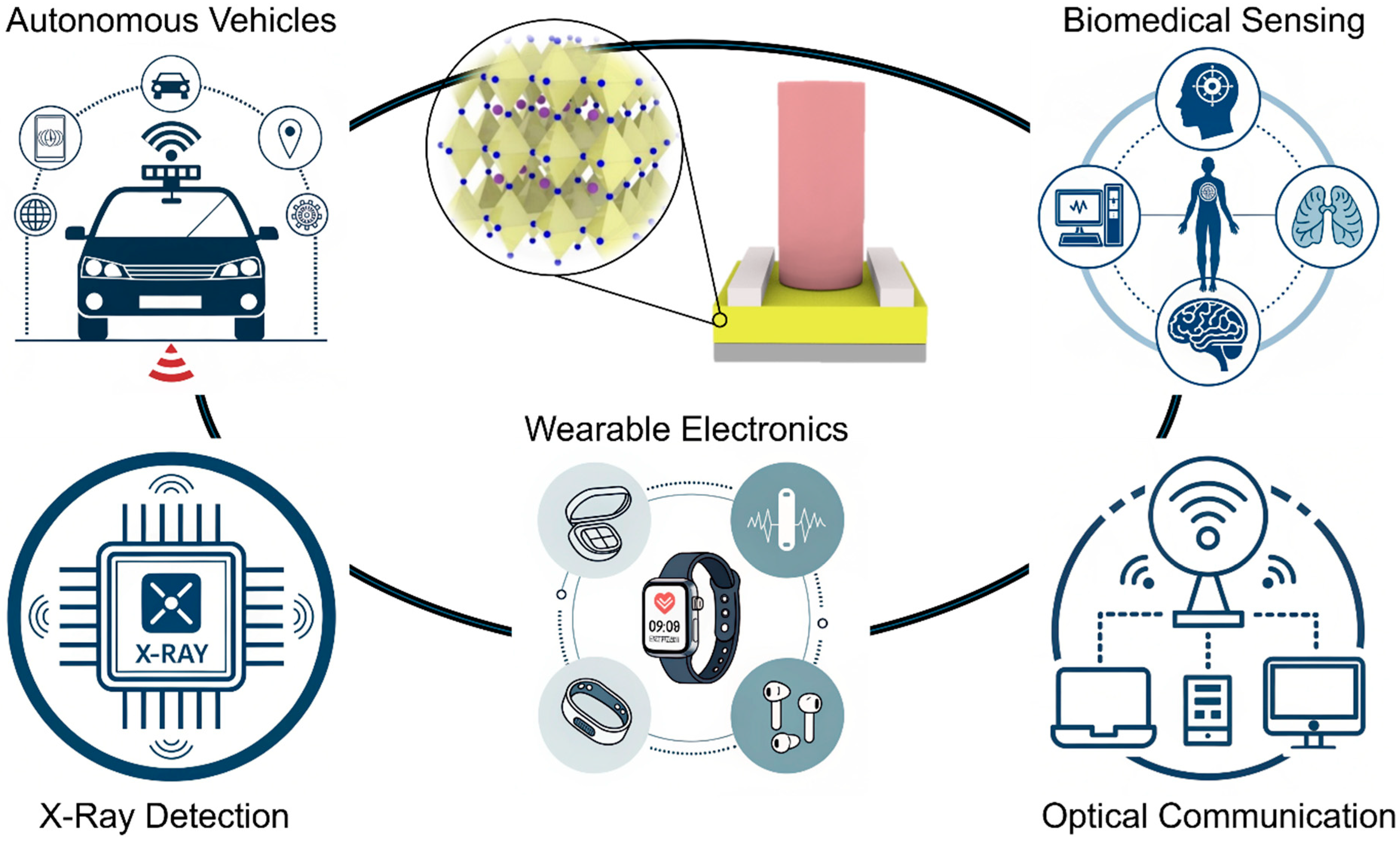
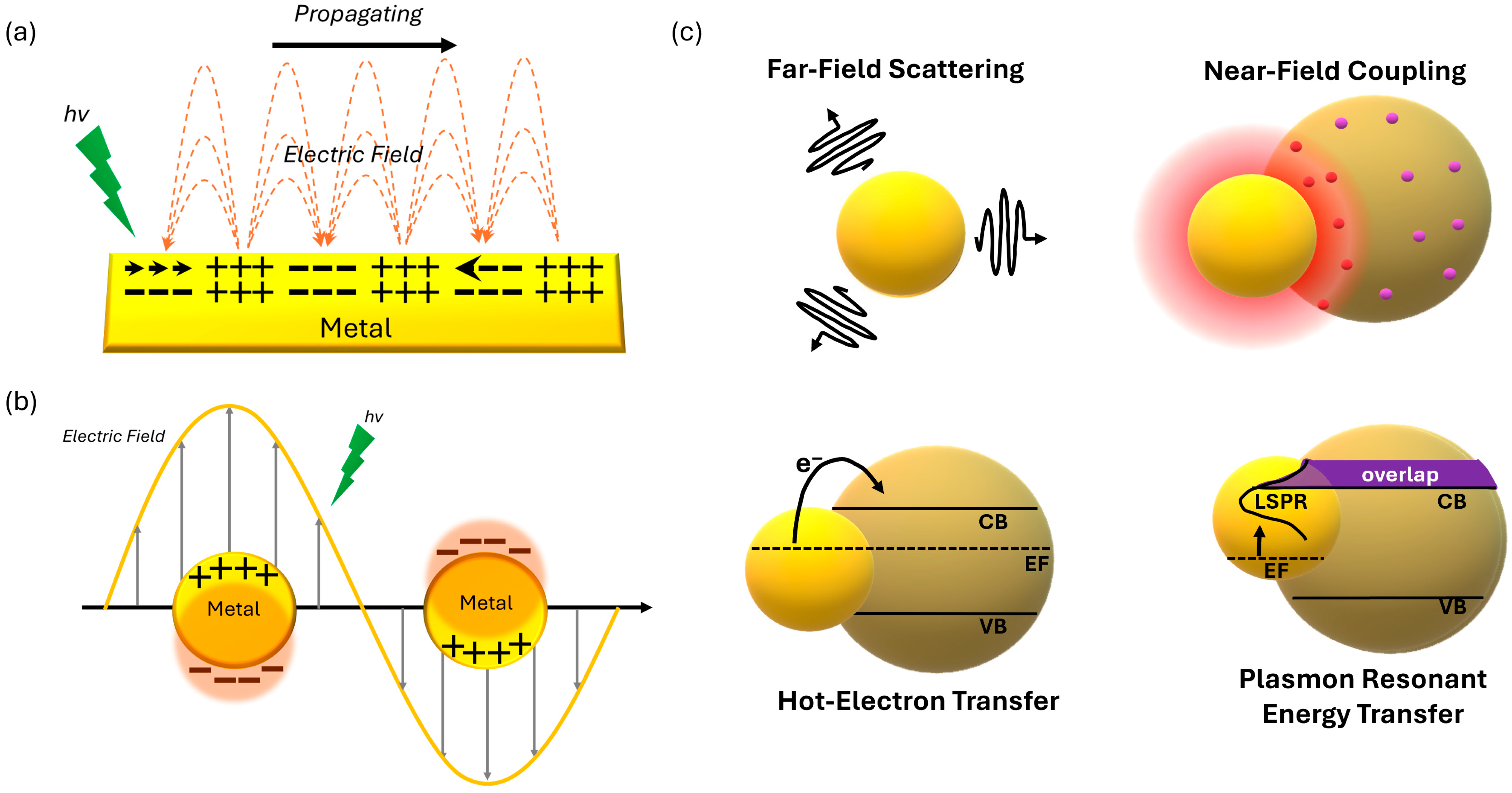
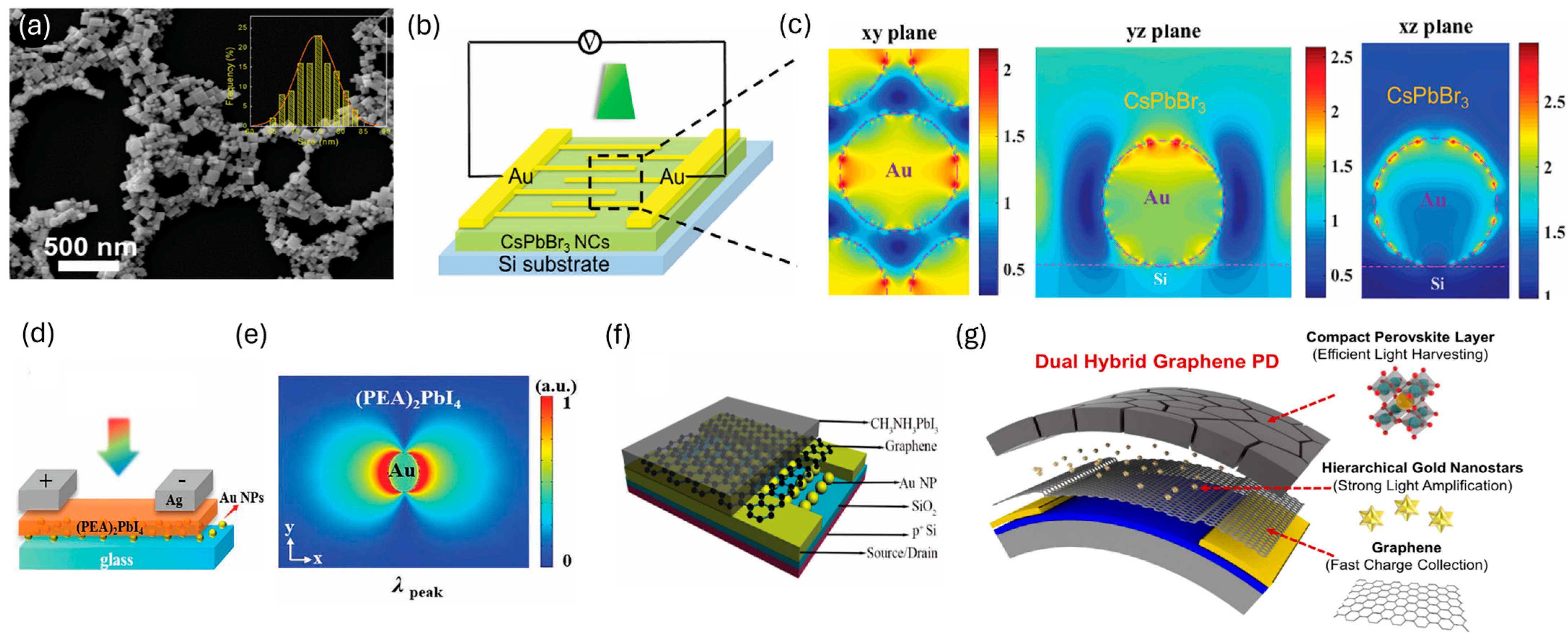
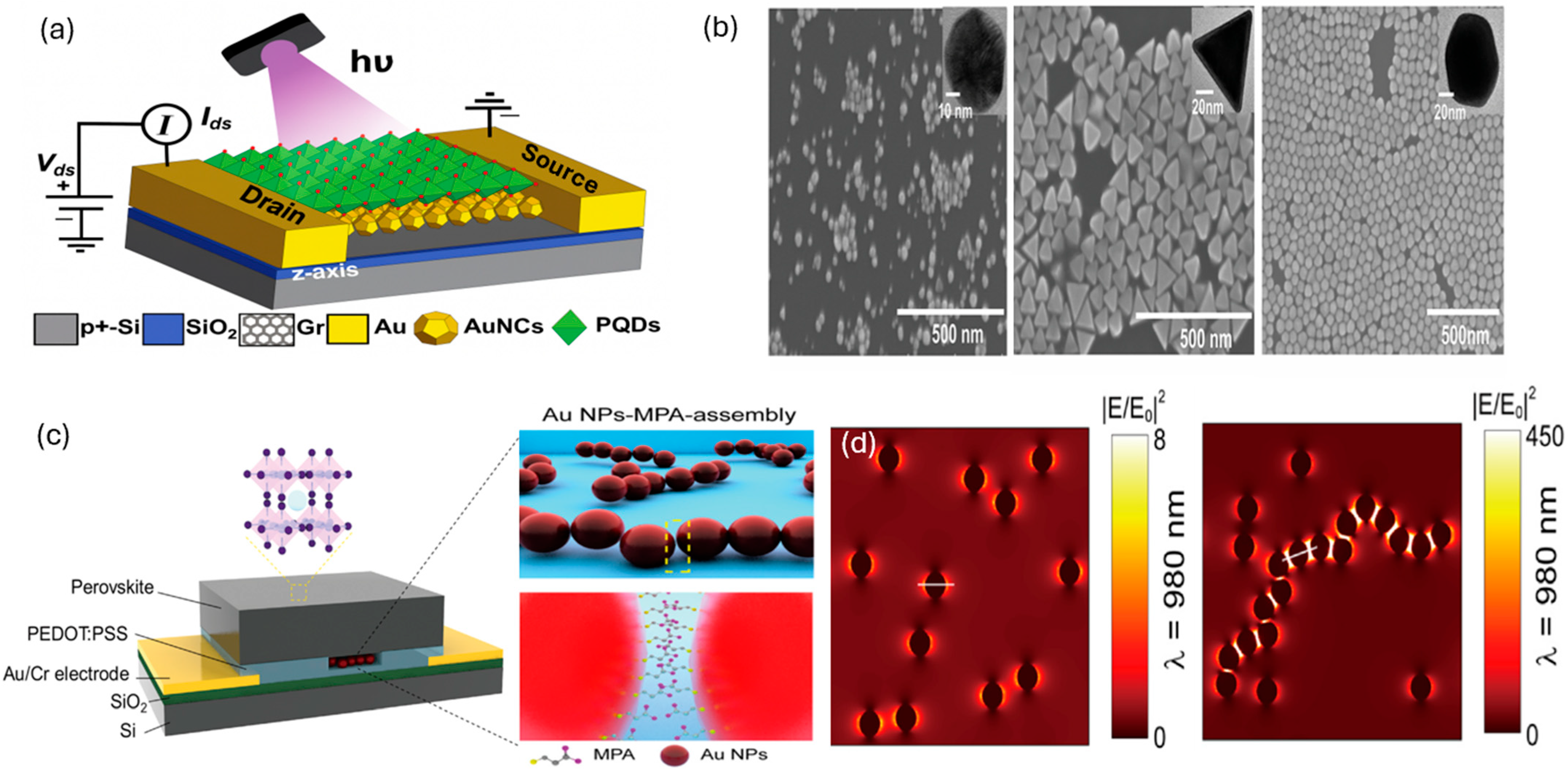
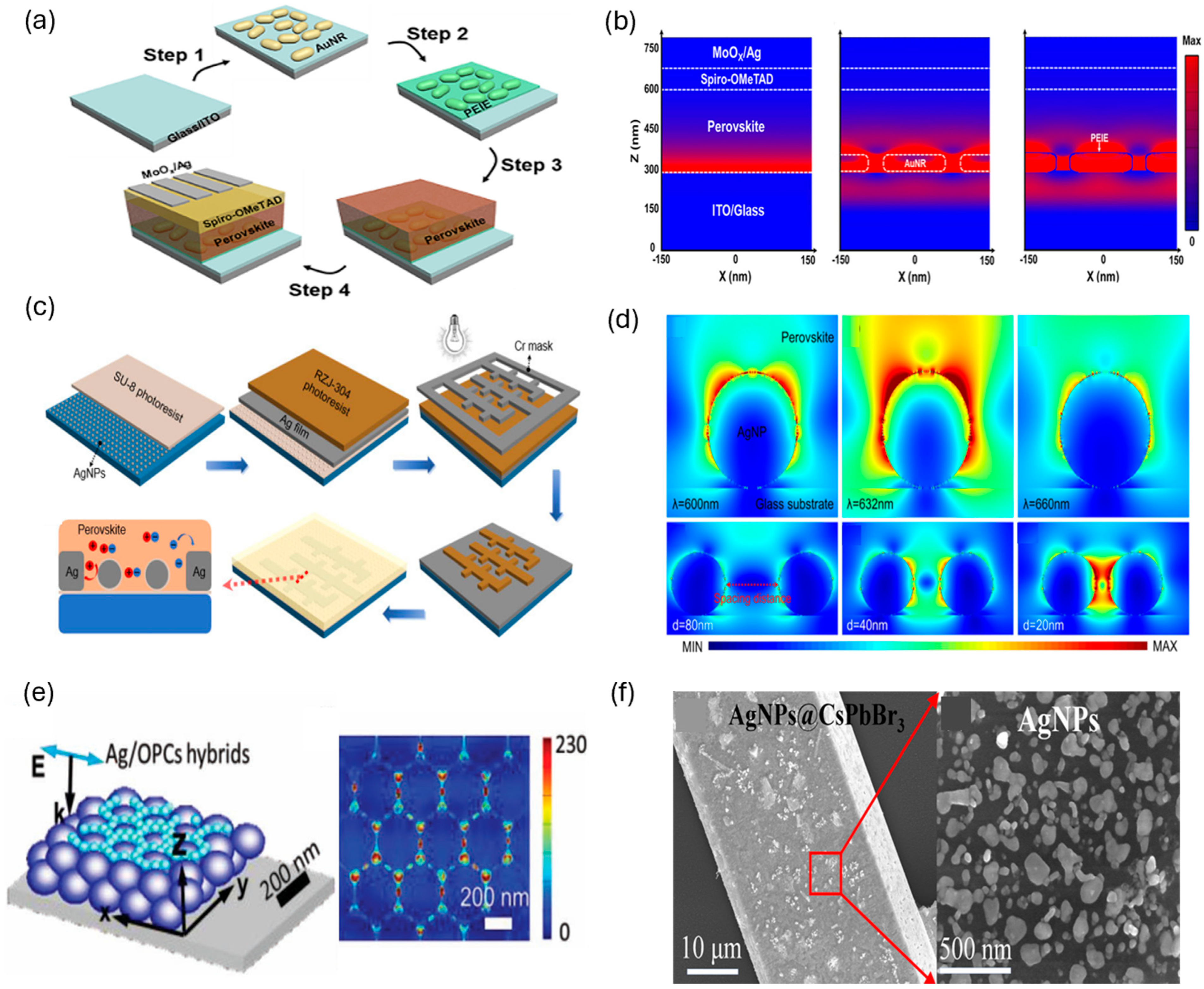

| Plasmonic Structure | Device Structure | Wavelength (nm) | Performance (with Plasmonics) | Improvement (%) | Ref |
|---|---|---|---|---|---|
| Au NPs | Au/CsPbBr3–Au NP film/Au NPs/Si | 532 | Iph = 831.1 μA, On/Off = 1.66 × 106, D* = 4.56 × 108 Jones | Iph = 238, On/Off = 1000 | [74] |
| Au NPs | Ag/(PEA)2PbI4/Au NPs/Glass | 565 | D* = 8.1 × 1014 Jones | EQE (650–900 nm) = 1000, EQE (480 nm) = 68.5, D* = 200 | [75] |
| Au NPs | Perovskite/Graphene/Au NPs/Si/SiO2 | 530 | R = 2 × 103 A W−1 | R = 200 | [76] |
| Gold nanostars (GNSs) | Perovskite/Graphene + GNS/Substrate | 532 | R = 5.90 × 104 A W−1, D* = 1.31 × 1013 Jones | R = 7.7 × 108, D* > 10000 | [77] |
| Au NCs (sphere/OD/RD) | PQDs/Graphene + Au NCs/Substrate | 432 | R = 2.7 × 105 A W−1, D* = 4.9 × 1013 Jones, EQE = 7.9 × 107% | Iph = 1000 | [78] |
| Au NP chains | Perovskite/PEDOT–PSS + Au NP chains/Substrate | 635 | R = 2063 A W−1, NEP = 1.93 × 1014 W Hz−1/2, D* = 1.16 × 1012 Jones | R = 410, NEP = 1560 | [79] |
| Au NRs + PEIE | MAPbI3/Au NRs + PEIE/ITO | 700 | R = 0.360 A W−1, D* = 1.81 × 1010 Jones, Idark = 2.93 × 10−10 A | Idark = 76% | [80] |
| Ag NPs + SU-8 | Perovskite/Ag NPs + SU-8/Glass | 632 | Iph = 0.86 μA, R = 0.478 A W−1, D* = 5.04 × 1010 | Iph = 352.6, R = 4.6, D* = 354 | [81] |
| Ag NPs + PMMA OPCs | CsPbCl3/Ag NPs + OPC/Substrate. | 410 | R = 8.1 A W−1, D* = 9 × 1014 Jones, τrise/fall = 28/31 ms | τrise/fall = 40–50% | [82] |
| Ag NPs | CsPbBr3 microwire/Ag NPs/p-GaN | 530 | R = 63.9 A W−1, D* = 4.05 × 1012 Jones, EQE = 1.5 × 104% | R = 550, D* = 600 | [83] |
| Au nanosquare array | MAPbI3 on patterned Au | 800 | EQE > 65%, IPh = 4.6 nA | EQE = 250, IPh = 900 | [84] |
| Au nanotriangles | MAPbI3 + Au triangles | 450 | R = 51 mA W−1, EQE = 12.6% | EQE = 300 | [85] |
| Al NP on AAO | CsPbBr3/Al NPs/AAO | 490 | R = 4.8 mA W−1, EQE: 1.12% | IPh = 4800, EQE = 4000 | [86] |
| CN-patterned Au | Si/SiO2/PS/Cr/Au/PVA/MAPbI3/Au | 670 | R = 588.6 mA W−1, EQE: 109%, D* = 22.5 × 1011 Jones | R = 420, EQE = 420, D* =346 | [63] |
| I-shaped perovskite metasurface | CsFAMA/PEDOT: PSS/metasurface | 0.1 (THz) | R = 94 A W−1, NEP = 5.03 pW Hz−1/2, D* = 3.28 × 1010, stability retained (<2% change after 240 days) | N/A | [87] |
| Au nanoislands | MAPbI3/plasmonic Au/TiO2 nanodiode | 563 | IPh = 552 nA | IPh = 400 | [66] |
| Triangular Ag nanopatterns | Triangular Ag nanopatterns/Al2O3/Perovskite/PMMA | 800 | glum (dissymmetry factor for luminescence) = 1.084 (MAPbI3), 0.524 (MAPbBr3) | N/A | [104] |
| Chiral perovskite metasurfaces | Nanoimprinted gammadion-shaped 2D-chiral perovskite nanocrystal metasurfaces | 520 | glum = 0.16 (CsPbBr1I2) | N/A | [105] |
| TiO2-coated chiral metasurfaces 2D gammadion perovskite nanocrystal arrays | 540 | glum = 0.56 (CsPbBr3) at 540 nm | N/A | [106] | |
| Focused Ion Beam-assisted gammadion perovskite metasurfaces | 750 | gCD (dissymmetry factor for absorbance) = 0.49 (MAPbI3) | N/A | [107] | |
| Triangular silicon chiral metasurface | Triangular silicon chiral metasurface/ITO/PEDOT–PSS/CsPbBr3/TPBi/LiF/Al | 520 | gEL (dissymmetry factor for electroluminescence) = 0.76 | N/A | [108] |
| Chiral Au NPs | ITO/chiral Au NPs/perovskite/PCBM/C60/BCP/Ag | 808 | gres (dissymmetry factor for responsivity) = 0.55 (Cs0.05FA0.5MA0.45Pb0.5Sn0.5I3), R = 0.35 A W−1, D* = 1.54 × 1013 Jones, EQE = 54.2%, Bending radius = 2.5 cm (without degrading gres), 90% retention of initial gres after the 1000 cycle test | N/A | [109] |
Disclaimer/Publisher’s Note: The statements, opinions and data contained in all publications are solely those of the individual author(s) and contributor(s) and not of MDPI and/or the editor(s). MDPI and/or the editor(s) disclaim responsibility for any injury to people or property resulting from any ideas, methods, instructions or products referred to in the content. |
© 2025 by the authors. Licensee MDPI, Basel, Switzerland. This article is an open access article distributed under the terms and conditions of the Creative Commons Attribution (CC BY) license (https://creativecommons.org/licenses/by/4.0/).
Share and Cite
Kim, H.; Lee, J.; Lee, C.B.; Lee, Y.H. Recent Progress of Plasmonic Perovskite Photodetectors. Inorganics 2025, 13, 351. https://doi.org/10.3390/inorganics13110351
Kim H, Lee J, Lee CB, Lee YH. Recent Progress of Plasmonic Perovskite Photodetectors. Inorganics. 2025; 13(11):351. https://doi.org/10.3390/inorganics13110351
Chicago/Turabian StyleKim, Hongki, Jeongeun Lee, Chae Bin Lee, and Yoon Ho Lee. 2025. "Recent Progress of Plasmonic Perovskite Photodetectors" Inorganics 13, no. 11: 351. https://doi.org/10.3390/inorganics13110351
APA StyleKim, H., Lee, J., Lee, C. B., & Lee, Y. H. (2025). Recent Progress of Plasmonic Perovskite Photodetectors. Inorganics, 13(11), 351. https://doi.org/10.3390/inorganics13110351






